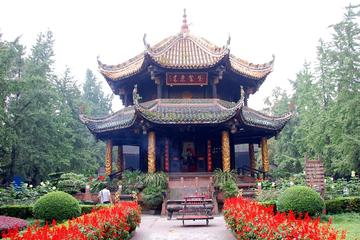Qingyang Palace
TIME : 2016/2/22 10:12:50

Qingyang Palace
An early Tang Dynasty classic, Qingyang Palace is considered to be one of the oldest and most important Taoist temples in all of China due to its location near the boyhood home of Lao-Tzu, the father of Taoism.
This palace is often referred to as the “Green Ram Temple,” the “Green Ram” refers to a pair of bronze goats which inhabit the temple’s Sanqing Hall. While one of the statues is decidedly a goat with horns, the second sculpture is a strange creature like no animal you’ve ever seen: with a mouse's ears, an ox's nose, a tiger's claw, a rabbit's mouth, a dragon's horns, a snake's tail, a horse's face, a goat's beard, a monkey's neck, a chicken's eyes, a dog's belly and a pig's thighs. The statue is an embodiment of all 12 animals in the Chinese zodiac. Despite their strange appearance, the two statues are easily the temple’s largest draw. They were imported from a curio store in Beijing more than 300 years ago and are now frequently rubbed by Qingyang Palace visitors who believe doing so will vanquish life’s troubles and pains.
As in other temples around Chengdu the temple grounds are a relaxing and enjoyable place for sipping a cup of green tea or watching locals engaged in a spirited game of mahjong. For Chengdu visitors with a deep interest in Taoism, a trip to Qingyang Palace is a great way to either pass the afternoon, or reflect on the ancient religion with a warm cup of tea and a comfortable seat from right within the walls of its source.
